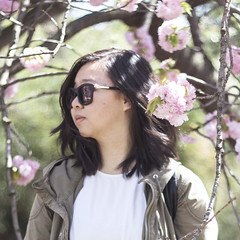Allergic reactions happen so infrequently that I sometimes forget there are risks to using, new or old, skincare and makeup potions. It is always advised to patch test new products before committing to slathering it on and it is best to keep to the expiration date or the quality of the product could be compromised.
If I am to be completely honest, 10 times out of 10 I forego patch-tests in hopes that I would be lucky—and luck has been with me so far. While I generally abide by the printed guidelines for older items in my stash, there are certain products where I tend to be a little more forgiving: if it is individually packaged, if I haven't opened it and exposed it to air yet, or if I am able to disinfect it with a rubbing alcohol spray.
I cannot say for sure what the exact cause for this particular reaction was, but I have my suspicions. Allergies could happen immediately or slowly, for some it could occur only if it so happened to meet the wrong combination of ingredients. For me, I think, it could have been either a new face oil sample sachet I tried in the morning or a past-due sheet mask I applied at night. I am not going to name any names because if it is the latter then it would have been completely avoidable had I not been too stingy to toss it. I wanted to share this post to mainly remind my future self in case of other mishaps.

Was that a little too overdramatic of a "warning"? Thought I'd give a heads up in case anyone gets queasy easily.

The reaction I had wasn't the worst possible case scenario but it sure gave me a good scare.

Day 1
If it was the expired mask, then I felt immediate itchiness and saw a few red patches on my face. I had used that particular mask when it wasn't expired before and had similar reactions, those never lasted long, which is why I brushed off the feeling and went straight to bed.
The following day proved to be completely abnormal. The itchiness and redness were still there but I applied my skincare and makeup as per usual anyway, hoping it would go away. It didn't... I say hope a lot because I didn't have any prior experience to guide me nor did I think it would be that severe.
Day 2
I woke up to a swollen face from a night of scratching in my sleep. Every inch of my face felt uncomfortably itchy, even on the eyelids and under my eyes. The reaction had spread down my neck and onto my earlobes (I had not applied any of the products there). I didn't notice just how inflamed the pustules on my chin were until after I looked in a mirror. It did feel painful but I had no idea it looked equally as bad.
To me, it looked like a pimple minefield. My chin is the most prone to acne, nowadays, but never to this degree. I also didn't know an allergic reaction could result in acne-like puss-filled bumps. It only grew in numbers as the day went on and each spot felt more and more inflamed and itchy.
At this point, I skipped all beauty products to let my skin breath and because I could not stand anything touching my skin. Even hair brushing against it made me feel itchy. I went to the doctor and oh the surprised and sympathetic looks the nurses and doctor gave! I left with 2 strong antihistamines (prednisone and hydroxyzine) and a steroid cream (mometasone). One med was supposed to help with the allergic reaction and bumps, the other pill and steroid cream were for the itchiness.
Day 3
The meds for the allergic reaction felt very effective. The inflamed bumps were mostly subsiding. The itching was still there but not as fiery as the day before. I don't know if I should attribute it to the pills or if it was the natural recovery process, the puss-filled bumps that were on my face were mostly dried out. I could easily flake it off like dead skin without being left with a chin full of puss and blood.
I decided to only use the steroid cream as a last resort. Luckily, I didn't need it.
Day 4 onwards
After all the bumps deflated, the aftermath I was left to deal with was dry, super dry, rough, and flaky skin. Think course sandpaper meets sunburnt skin. Even though my skin needed moisturizing and exfoliating the most, I couldn't deliver at first because the itchiness was still there. All I could do was ignore it for the time being or subconsciously scratch and pick at my face throughout the day. Mostly it was the latter.
My skin probably felt comfortable enough for light moisturizing and cleansing around the 5th day after the skin allergy. I couldn't have been happier to have a watery-type essence product in my stash—it absorbed quickly and most importantly didn't feel like there was a layer sitting on my skin. I needed something that was like water but had more benefits. The essence alone was definitely not enough moisture, but I mainly wanted to relieve some of the tightness my skin felt from being so parched. Rather than being itchy from the allergic reaction, my face felt itchy from being too dry.
The flakes and roughness went away after another day or two of moisturizing. A gentle physical exfoliator helped a tiny bit, but I think it was mainly because the moisturizing helped soften the patches enough beforehand.

Prior to getting prescription strength medicine, I tried both Zyrtec (seasonal allergy meds) and Benadryl (stronger OTC allergy meds). Neither helped with calming the reaction.
Those who are the low-maintenance type will probably wonder if all this is worth it. Skin conditions might be bad but if you don't do anything extra to it, idealistically it shouldn't get any worst. For those who are of the higher-maintenance crowd, like me, this is more of a painful learning experience. It isn't so much about it not getting any worst and more about how it could get better.
The idea of stuffing our faces silly with nothing but our hands could sound archaic to those who are used to utensils and pre-portioned plates. Oh...all the germs and dirty hands! I am a firm believer in the notion of "big germs eat little germs" (it sounds better in Chinese 大菌吃小菌 ); a little bit of bacterium will only add to build immunity.
In reality, there are many cultures that have eaten with their bodily utensils for, probably, centuries. It isn't any less unmannered or uncultured, just a different set of customs: using only a specific hand, pinching rice with specific fingers, scooping meat in a particular way, and the list goes on. If the whole table does the same thing, then is it really weird anymore?
I would imagine everyone's inner kid would especially love this style of eating—so much freedom to lick the leftover sauces from your fingertips and savor every last bit. No one has to pretend to be neat and tidy either. The life!
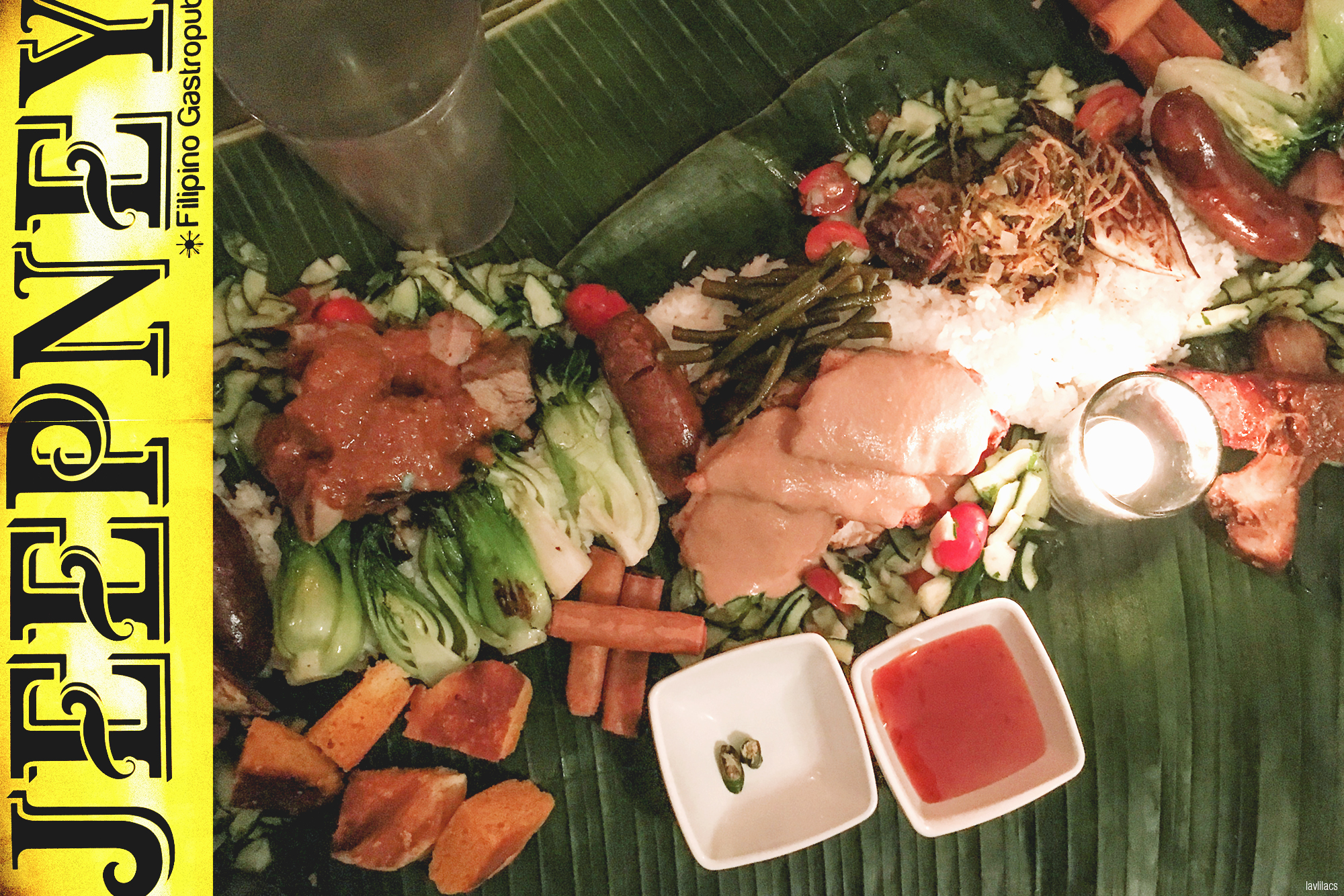
Jeepney is a Filipino Gastropub in New York City's East Village. They have normal plated service every day. On Wednesdays and Thursdays of the week, and if specially reserved otherwise, the restaurant offers what they call Kamayan Night. This does require an inquiry for reservation ahead of time via a dedicated form on their website. If the availability is right, they will reply via e-mail with a link to another form for a proper reservation. Then you and your party of 4+ could decide on what foods to pre-order.
Just to clarify, I know next to nothing about Filipino culture and cuisine so I could be slightly off. Kamayan style eating is synonymous with family and get-togethers. It is also a type of meal that is reserved for special occasions, but everyone is still familiar with. People gather around a table that uses banana leaves for tablecloths and ladened with rice, meats, veggies, and other finger foods. This was perfect for my friends and I because we were celebrating 2 birthdays and a new job.
Yelp reviews say that Kamayan Night is very popular; reservations made way in advance is highly recommended. We must have been quite lucky since I made the actual request for a reservation only a few days beforehand. It could also be that we chose a time earlier on in the night (6:30 PM). Communication with Jeepney was very speedy.
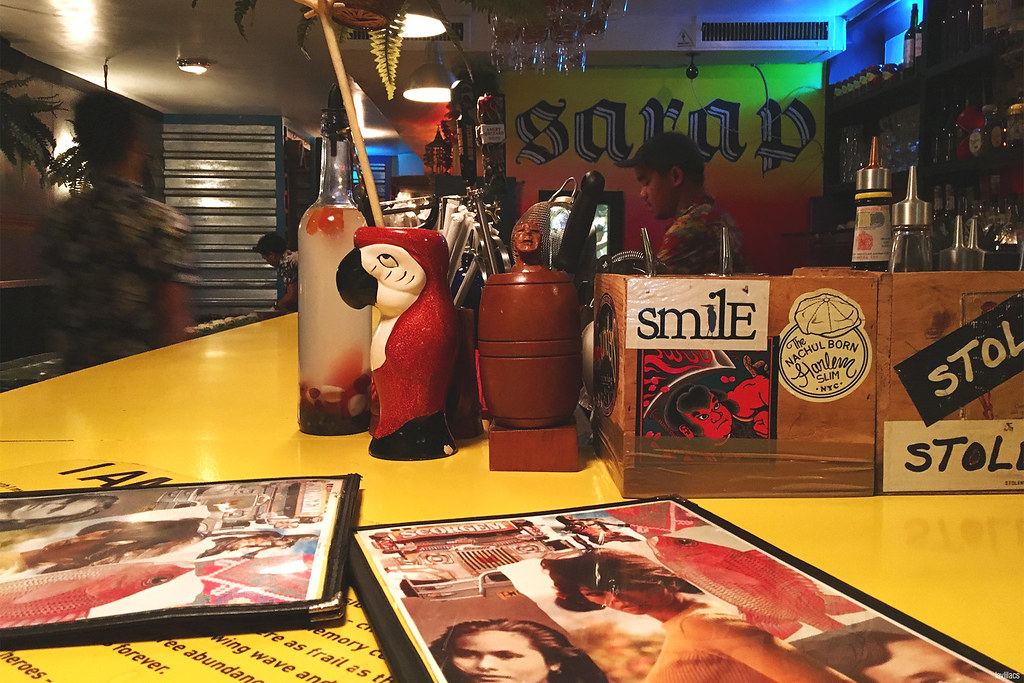
Even on the Kamayan Nights, they have space for customers who want to order plates of food as well. There is quite a lot of bar seating and side-by-side chairs near the front of the restaurant.
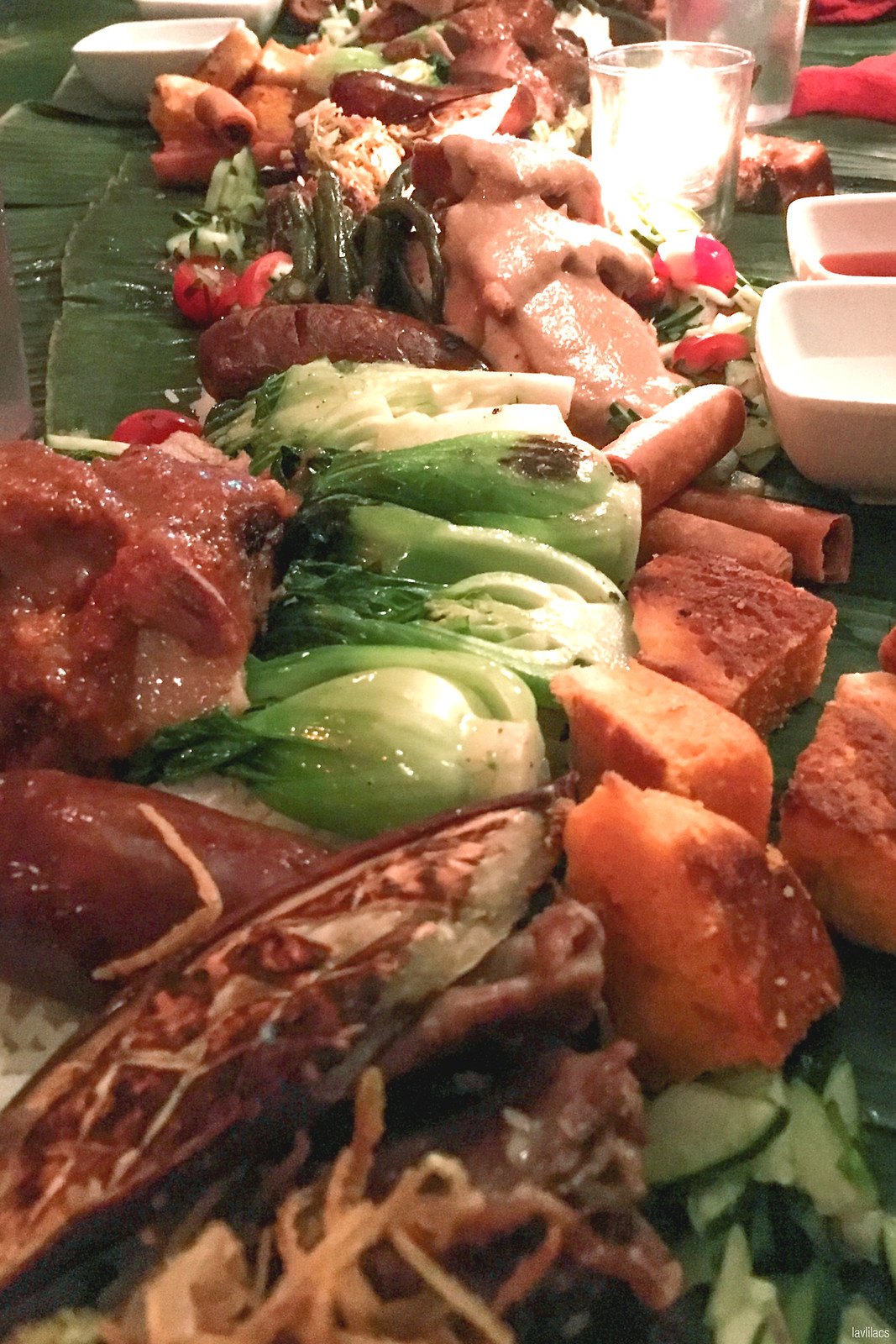
The staff starts to assemble the dinner spread when they've confirmed most of your party arrived. It takes maybe around 15-20 minutes to have everything ready before everyone could sit. The waiter or waitress will hand out hot towels, explain each component, and how properly eat & dip foods Filipino style.
It might look like a mish-mash of food, but everything is placed with thought. The same grouping of food replicates 6 times down the row for our group of 6 diners. Everyone theoretically has their own area to cover but where is the fun in that when food is display this way? We gave little thought to sticking to what was in front of us and just picked whichever food we felt like eating, even if it meant dipping into "other's pile".
The below was the options we were given at the time. Jeepney might change some things up depending on availability and such.
Pulutan // Small Plates (Choice of 2)
Fried tripe - With spicy banana ketchup
Chicharon bulaklak - Crispy ruffle fat
Lumpiang Shanghai - Beef and pork, carrots, water chestnuts, xiao xing, rice paper
Tahong - Steamed mussels, tanglad, shallots, garlic, sili, San Miguel beer
Ukoy fritters - Julianned kamote, carrots, onions, rock shrimp
Banana ketchup ribs - Pork ribs, Filipino dry rub, spice banana barbeque glaze
Batangas bone marrow - Ginger, patis (supplement $2/person)
Ulam // Large Plates (Choice of 3)
Adobong hipon - Head on shrimp sauteed in garlic, ginger, vinegar & bay leaf
Inasal na manok - Roasted chicken marinated in lemongrass, calamansi, soy sauce & achuete butter
Bicol express - Slow-roasted pork shoulder, coconut milk, sili & bagoong
Dinuguan & puto - Boneless port sholder, beef blood, suka, sili, bay leaf, San Miguel lager, served with crispy puto pancake
Kare kare fried chicken - Boneless crispy chicken, peanut butters sauce, pickled long beans
Short rib pares - Braised short rib, star anise, caramelized onion, fried leek, eggplant a la plancha (supplement $4/person)
Dampa fry - Whole market fish, fried hard served with blistered chilies, scallions & escabeche (supplement $4/person)
Rice (Choice of 1)
Jasmine rice - plain rice
Garlic rice - Pinoy staple for garlic lovers with garlic chips (supplement $1/person)
Chino-Latino coconut - Coconut rice with toasted coconut flakes (supplement $2/person)
Drinks
They offer a bunch of options for unlimited draft beer, cocktails, premium alcohol for $25-55/person. Since our group, in general, aren't heavy drinkers we chose to order drinks separately the day of.
Cost & Fees
Base cost: $45/person
Additional food supplemental fees: varies from $1 to $4/person per dish
NYC sales tax
20% service charges (18% tips + 2% admin fee)
Cancellation fee within 48 hours of reservation: 50% of total bill
Cancellation fee or no-show on day-of: 100% of total bill
Our total that night, including tax, service fee, and 1 supplemental food fee: $64/person
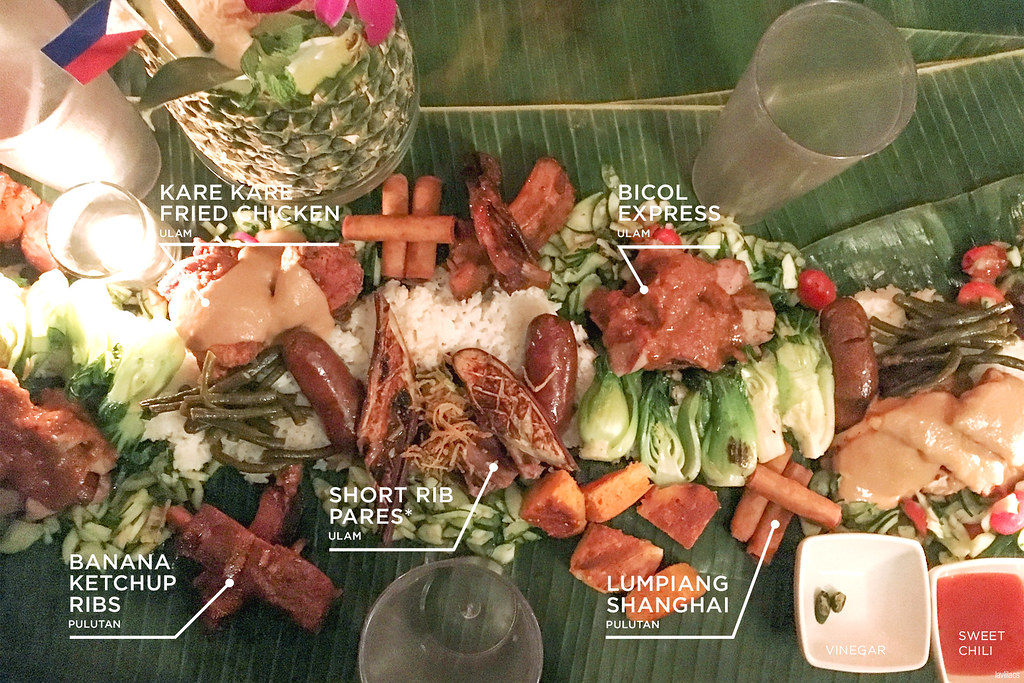
I think the hardest part about Kamayan night is choosing which foods to order from their selection. It seems that no matter the party size, groups are limited to 2 "appetizers" and 3 "entrees". Everything they described just sounds so delicious. If it wasn't Kamayan Night, we could have easily ordered a few more of the "pulutan" and "ulam" dishes to share.
My friends all agreed that both the Banana Ketchup Ribs and Lumpiang Shanghai were bomb. The meat on the ribs completely fell off the bone and was very juicy and saucy. Where has banana ketchup been all our lives?? Even though it would have been nice to try some of the more unique appetizers, the lumpiang (spring rolls) gave a much-needed crunch amidst all the soft and tender meats.
Of the main meats we chose, favorites were pretty unanimous: Bicol Express, followed by Short Rib Pares, and then Kare Kare Fried Chicken. The slow-roasted pork shoulder (Bicol Express) had the right amount of sauce and the meat was amazingly tender. We loved covering the rice with that magical sauce. While we enjoyed the fall-apart braised short ribs, it would have been even better with more sauce. It wasn't lacking in flavor, but some pieces needed the extra juice and moisture. The fried chicken meat, on the other hand, was a tad too dry especially considering how large the each piece was.
If I were to ever eat at Jeepney again, not just for Kamayan but even for regular service, I would love to try their dampa fry (whole fried fish). It seems to be a pretty popular choice on Yelp and I noticed quite a lot of them on the service counter when we were eating that night.
The longanisa (sweet Filipino sausage), sweet orange-tinted bread (possible coconut flavored), cucumber salad, and Shanghai bok choy seem to be included no matter what sides and mains are chosen. Vinegar is recommended for dipping almost anything on the table into; it serves to cut the sweetness and grease. The sweet chili is typically reserved for the lumpiang.
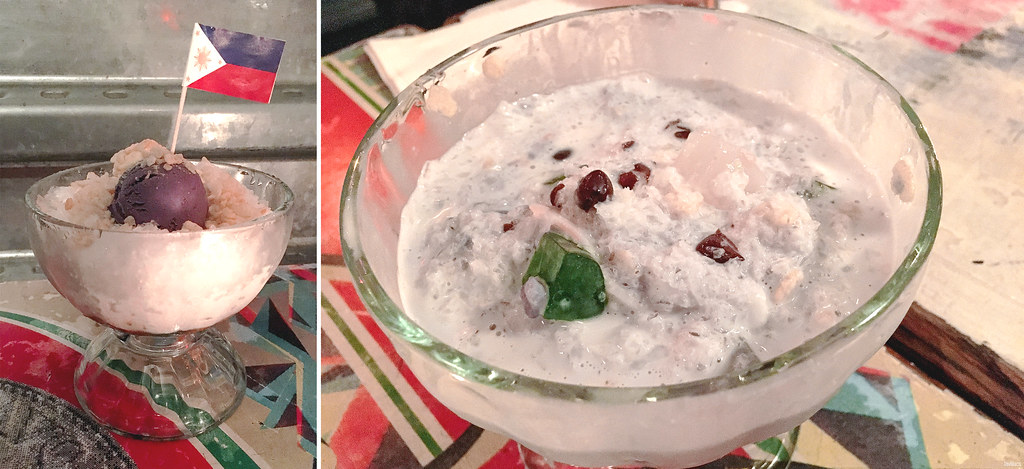
We were told a Filipino meal isn't complete without ube (purple sweet potato) and halo halo (mixed ice dessert with sweet beans, jello, and evaporated milk). There aren't any options for dessert with the Kamayan feast, but the Halo Halo was much appreciated after all the heavy foods. We were given 2 bowls to share amongst the 6 of us.
The staff even gave us a round of complimentary ube shots! It could have been that he knew someone in our group or because they found out we were celebrating multiple occasions that night.
My friends and I devoured a good 75% of the food on the table. We only had enough leftovers for 2 loosely packed boxes. I would definitely not recommend gorging until you are silly and delirious because we were seriously full that night for ages. It was harder to control how much we ate since the food was in a big 'ole pile. Just remember to pace it out and take smaller pinches of food instead of handfuls. No one will judge you for leaving a ton of food at the end. In fact, I think it is very appropriate in Filipino culture to have leftovers pack for home.

Sometimes the little things are easy to miss: the way signs are designed, the way everyone stands or doesn't stand on a line, to even how tableware is offered. These are the kind of differences that are just there, a part of everyday life, and easy to dismiss. But once those subtleties are discovered, it opens a new world of observation.
*Warning: Info heavy! But I am only going to scratch the surface of each since this is just for comparison's sake. I didn't realize how much I actually had to say...

New York City has the MTA. Hong Kong has the MTR. Guangzhou has the Metro. When land is wide and people aplenty, trains and subways are usually more efficient and effective at getting where one needs to be. Unless you are rolling in money or can have your transport fees compensated for, most people take mass transit when traveling.
Granted the MTA is old and there is only so much they can fix without making it a, even more, pain in the butt for the millions of daily riders. A girl can dream—hoping for contactless Metrocards, reliable "Next train's arrival" signs, and staircase exit numbers and directories.
Above Ground Station Signs
NYC: White text on black, followed by colorful circles with either a number or letter. Many stations also have green globes or half green half white globes, usually on pillars, next to the black signs.
*Subway and train are interchangeable in NYC. No one uses metro here. Outside of the 5 boroughs though...those are all trains.
HK: 1) White text on navy, usually next to a maroon logo. 2) Navy text on silver, next to a maroon logo. 3) Maroon logo only.
*Subway and metro are 2 very different things in Hong Kong. Metro is almost exclusively the rapid transit. Subway could also mean an underground walkway that goes below a big multi-lane road.
GZ: All white text on red. Shows their logo, station name, and entrance/exit letter.
Station's Exit Signs
NYC: Exit signs will only tell you what street the staircase is on and whether the staircase is NSWE on the block. It is pretty useless if one station has many exits that are close together. It is only helpful you know exactly where you want to go and where that location is in terms of NSWE to where that particular staircase is. To be honest, who knows that right off the bat or has the time to think of that in such a short amount of time?
HK: There are generally loads of directories to point towards exits which are lettered A to whatever. Each letter is typically associated with at least one specific nearby destination: street names, malls, schools, hotels, museums, etc. It is particularly useful if you have access to a phone map and can give yourself some context of the surroundings. The exit letters are only available on the inside of the stations or very discretely on the side of an entranceway.
GZ: Like in Hong Kong, exists are also given letters and corresponds to a local landmark. Unlike in HK, the exit letter is also posted on the entrance side of the metro. This is useful if you have to meet someone at a certain station and can then name a specific entrance letter versus "the one on so and so street, you know next to the shop".
Transit Card/Fares
NYC: Pay per ride Metrocards, weekly cards (1 time pay for 7 consecutive day use), or monthly cards.
The fare is standard no matter the distance. Allowed 1 transfer to a bus or from a bus within a 2-hour period. A Metrocard costs an additional USD $1 and can only be used for the MTA. It can only be swiped to take the subway or inserted to take buses, it is not needed to re-swipe when leaving the station.
HK: Round trip station-specific tickets or the Octopus card.
The fare differs depending on the distance traveled. An Octopus card requires an HKD $50 refundable deposit and an initial HK $100 stored value. Possible alternatives to the card are ornaments (phone charms, key rings, watches etc.) and special phone SIM cards. All versions are contactless and can be used across multiple modes of transit (subways, buses, taxis), public payphones, vending machines, and convenience stores. Unlike in NYC, the smart chip enabled card or charm needs to be tapped when both entering and leaving.
GZ: Single-trip token ticket, 1-day pass, 3-day pass, Yang Cheng Tong Smart Card.
The fare differs depending on the distance traveled. (I believe) The single-trip and day-passes have no deposit fees. The Yang Cheng Tong requires an RMB 30 refundable deposit fee. All are tap-only and can be used on multiple transits and at some consumer stores, needs to be tapped when entering and leaving as well.
Transit Operation Times
NYC: 24 hours. Trains and buses at off hours are just more sparse.
HK: 5:30 AM to 12:30 AM.
GZ: 6:00 AM to 11:30 PM.

Platform Safety
NYC: Barrier-less. The only thing keeping you safe from an oncoming train is yourself and your senses. Pushing, whether accidentally or not, is a thing. "Be careful of the oncoming train traffic. Standing on or at the yellow platform edge strip is dangerous."
HK & GZ: Most stations, outdoor and indoor, have a glass barrier sliding-door mechanism. Floors have arrows to direct the waiting crowd.
Platform Etiquette
NYC: If you're lucky, people waiting for the train will be nice enough to step to one side when the doors open. It is more normal for people to do whatever they want and have a "me first" mentality.
HK: People in Hong Kong mostly follow the arrows and allow space for alighting passengers to first leave. When it is peak rush hour, the HK MTR even has uniformed attendants directing traffic: how much more people can go on safely, which doors are less crowded, etc.
GZ: I can't say for sure what Guangzhou is like since I took the train at off-peak hours only a couple of times.

Escalator Etiquette
NYC & CN: If the waiting situation is any clue, the escalators are also a "do whatever" kind of style. Most of the time it is zig-zagging, on rarer occasions it might be some kind of an off-to-one-side situation. Apparently, some reports say this is actually more efficient and doesn't force a crowd at the starting point.
HK: Being on escalators in Hong Kong was a little weird at first. It is easier to follow the crowd and step to the right side when I was one person. When I was with someone else, we were more than likely to stand next to each other and effectively block the walking zone. Once I got the hang of it, standing ahead of my companion and following the local mannerisms wasn't too difficult.
As someone who usually waits for people to get off the train first in NYC, I thought to allow a walkway was a neat idea. It is good for those really in a rush. But I do see where the studies come from when they say the single-file system is slower and potentially more dangerous. Just stay put and let the moving stairs do its thing!

Elevator Numbering
Other than the fact that some Chinese elevators don't have a specified 4th floor, because 4 in Chinese sounds similar to the word for death, I found Hong Kong's floor labeling situation very difficult to adjust to.
NYC & CN: Most street level floors start at 1 and ascends. I want to say a majority of the underground levels become B or B1, B2, and so on. But don't quote me on that because not many places have multiple underground floors.
Most elevator sensors in NYC are pretty forgiving if anyone is anywhere near the doors. Of the ones I rode in China, I felt like most were unforgiving. Unless the button is pressed at a precise moment, a hand or anything else placed between the closing doors be clamped on.
HK: The street level floors in Hong Kong all begin with G for Ground level and continues to 1 and above. I can't count the number of times I or my mom or Aunt pressed the 1st floor button wanting to go to G. I remember the first time I asked for directions in a mall and was directed to go to the 1st floor but upwards, my brain had to do a double-take.

Internet Speed & Access
HK and NYC are more or less equal in terms of access. Nothing is particularly forbidden unless a company or specific place limits certain sites and apps for their own business benefits. The major difference comes in the internet connection speeds. I cannot say what the specific numbers were; browsing the internet in Hong Kong, whether at the airport or in most hotels, just felt faster than in most places in NYC.
China is a whole different beast. It is no surprise that it has the worst accessibility, maybe second to North Korea. Most websites and apps that non-China based humans frequent are unloadable. The minute I crossed the border from Hong Kong to Shenzhen, China, the cellular provider ends and so does the connection to the world (quite literally). Surprisingly, notifications still came through but it was impossible to actually load the app. WeChat and local phone calls were the only forms of communication I had there and even that required a new China SIM card.
I have heard that if your service provider at home has a global plan that covers China, it is possible to access everything. Otherwise, the VPN route wasn't necessary for me since I never stayed in China long enough to need the internet constantly on any given day. Internet speeds in most of the hotels, up and down China, big and small cities, were either at a bearable average speed or too slow to handle. It was less frustrating to turn on the TV to pass leisure time.

Smoking Culture
I know, it is impossible to find anywhere where cigarettes and nicotine do not exist. But at least in most developed/major cities where someone can smoke a butt is well regulated. If the sign says "No Smoking" or you'll pay a fine, it means it. If there isn't a sign, at least it is a widely followed practice to not puff inside.
The level of bearableness goes from most to least: NYC, HK, and then CN.
NY & HK: People seem to follow the rules and etiquette well. It just felt slightly less tolerable in HK because of the number of smokers in such a small compact space.
CN: While there do seem to be laws to control smoking, it didn't seem to be heavily enforced wherever I visited. Hotel rooms and hallways reeked of lingering cigarettes scent. Many restaurants that we ate at, especially in Taishan and Guangzhou, allowed customers to smoke...inside...at the table. Heck, ash trays were norms and burnt holes were abundant enough to be design elements on the table clothes.

Hotel Facilities
NYC & HK: Lobbies are commonly found on the street level floor of most hotels. No matter if the hotel spreads out height-wise or width-wise, the next closest and most common facilities to the lobby are the restaurant(s), gym, conference rooms, and any other extras. The guest rooms typically occupy the upper or outer perimeter. Hotels are places where visitors not only sleep in but for some to dine, wine, and relax at.
CN: I found the facilities at hotels in China very interesting. Unless it is a Western brand chain or luxury Chinese brand, gyms and conferences rooms were pretty non-existent. Restaurants were a must and "fanciers" hotels had multiple. Many of the hotels had karaokes in the same building or in a structure right door. In the China-based budget hotels I stayed at, thin walls and windows plus late night music blasting plus cigarette smell made for very terrible sleeps.

(Chinese) Restaurant Table Setting
NYC: I think I'll just apply this to most Chinese (especially Cantonese) restaurants in the USA and maybe Canada. The typical tableware that customers all get is a napkin, a plate, a teacup, and chopsticks. If you order rice or anything that is liquidy, bowls and spoons will be supplemented.
It is common practice to wipe down the tableware with the napkin before reaching for any food. Customers are expected to eat off the plate. Waiters, who are usually also bus boys, will come around periodically to replace dirty/filled platters with new ones.
HK & CN: Bowls and spoons are included in the tableware set. Rather than to eat off the plate, food is expected to be placed in the bowls and scraps/bones on the plate. There is less of a need to collect and replace dishes.
The biggest difference I had to adjust to was the cleaning of tableware with piping hot water or tea before eating. Even if the set is distributed in sterilized plastic covering, it is always re-sterilized with hot liquid for good measure.

Dimsum Ordering
NYC: Dimsum is a must eat whenever my family travels anywhere. The first breakfast meal my parents looks for is to go yumcha. Even in the USA and Canada, I think New York City is one of the few, if not only place, where dimsum is still served in push carts. Most places elsewhere have everything cooked to order via a checklist system. I personally prefer the carts because I like to see what I am going to get. I can still make some kind of judgment even if I don't know what the name is.
HK & CN: The checklist system is probably a more efficient method. Most food is cooked to order and minimizes the amount of stuff that sits out. Restaurants could hire fewer people to walk around to push the carts. More tables and chairs could be put out to make up for space not needed by the steamer on wheels.
Unless the menu has photos thought, which they rarely do at non-tourist spots, it is difficult for non-Chinese reading customers to order. I guess it adds to the fun of trying local spots, eh?
Dimsum Culture
NYC: While Cantonese restaurants serve dimsum every day of the week from opening until around 2 PM, the restaurants are busiest from 11 AM until 2 PM. Customers who frequent early in the morning are the every-dayers and retired folk. Numbers are given out by the host when rush hour hits. Sometimes the numbers make sense, typically it doesn't. It is most beneficial to know someone working there.
HK & CN: The homeland of dimsum and yumcha, of course, offers it every day of the week. The time ranges people visit and the restaurant service times were unfamiliar. A majority of people prefer to go for early morning dimsum (before 10-11 AM). Then there seemed to be a sort of second dimsum session in some places during the lunch/early afternoon hours where prices are slightly different. I even went to a restaurant for late night dimsum for dinner once and heard my mom's friends say they wanted to meet for late night dimsum after dinner (past 9-10 PM) as well. That was a concept completely new to me.
I have heard of all-day dimsum only establishments before, i.e. Tim Ho Wan and Nom Wah. But Cantonese restaurants that also had dinner service who ended their nights with dimsum felt slightly bizarre. Almost wrong, but somehow right; they have to prepare for dimsum service the next day anyways, I guess?




















